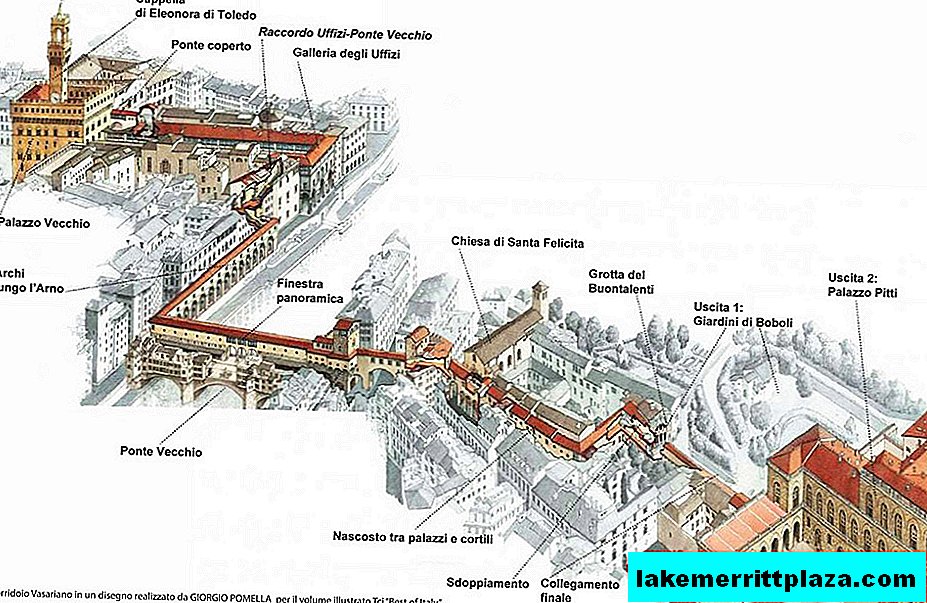The Corridoio Vasariano is a world-famous gallery between the Palazzo Vecchio and the Palazzo Pitti in the center of the historical part of Florence (Firenze).

History of construction
A 750-meter-long gallery appeared at the behest of the Duke of Tuscany, Cosimo I of Medici in 1565. The purpose of the construction was to connect the house on the west bank of the river, where the Medici family lived, with the Palazzo Vecchio, in which the Toscana government was located, by secret passage. In such a secret passage one could move without leaving the city. The construction was timed to the day of marriage between the son of Cosimo I - Francesco I Medici - and John of Austria from the Habsburg dynasty. Therefore, the construction was carried out in a short time: A gallery designed by Giorgio Vasari was built in 5 months.

In the Vasari corridor, original construction techniques were used:
- Part of the corridor runs wall to wall with the Church of Santa Felicita, a balcony window was made there so that Cosimo I was present at the service, not visible to church visitors;
- The most famous section of the gallery is located on the Ponte Vecchio bridge (Ponte Vecchio) and striking with panoramic windows, from which you can see the Arno River to the very bridge Ponte Santa Trinita Ponte Santa Trinita);
- During the construction, jewelers' shops appeared on the Ponte Vecchio bridge instead of shops selling fish and meat products, so that unpleasant smells and paintings did not irritate senior officials.
The secret passage of the Medici family
The corridor consists of several segments:
- From the chapel of Eleanor of Toledo to the Palazzo Vecchio in the "Hall of Five" (Salone dei Cinquecento), decorated by decree of Savonarola and turned into a room for ceremonies at the behest of Cosimo Medici;
- Passage with busts and portraits of representatives of the Medici clan in the Uffizi;
- The gallery section, which is now accessible only to organized groups according to a special schedule and is easily recognizable by round windows with bars outside, stretches along the promenade to the Ponte Vecchio bridge - here is a unique collection of this storehouse;
- The corridor above the residential and commercial premises of the bridge over Arno;
- Crossings over residential buildings on the west bank of Arno and along the church of Santa Felicita, and from there to the Palazzo Pitti;
- Go to the Boboli Gardens (Giardino diBoboli), decorated with fountains, grottoes, sculptural compositions.

The Vasari corridor in Florence was repeatedly restored, but the appearance was practically unchanged. Changes were made only a few times:
- in 1939 the area of windows was increased by order of Benito Mussolini;
- in 2013, a department dedicated to self-portraits of 21st century artists appeared at the end of the covered corridor.
Now the Vasari Gallery is part of the Uffizi Museum.
Gallery Treasures
In the Vasari Gallery canvases of 16-17 centuries are stored. famous artists of Rome (Roma) and Naples (Napoli). A special part of the collection is self-portraits of painters from Italy and other countries of the 16-20 centuries:
- Giorgio Vasari;
- Rafael Santi;
- Peter Paul Rubens;
- Diego Velazquez;
- Orest Kiprensky;
- Boris Kustodiev;
- Ivan Aivazovsky;
- Marc Chagall et al.

The collection of self-portraits is constantly growing: artists consider it an honor to present a self-portrait to the Vasari Gallery.
The Vasari Gallery presents a collection of about one and a half thousand self-portraits and 700 other paintings. The uniqueness of the collection is that, with rare exceptions, the originals are preserved here, giving a complete picture of the work of the master.
The Vasari corridor presents another page in the history of the development of art: there are paintings damaged by the explosion at the Uffizi Gallery in May 1993. Fragments of paintings cut by fragments glued onto black tablets acquired a symbolic significance and it was decided not to be restored.
How to get
The exhibition, housed in the Vasari Gallery, is of particular value, but due to the events of 1993, the entrance to the museum is limited. Until 2016, the corridor was open for tourists only a few days a year, during national celebrations.
According to the new plan, the entire Vasari Corridor will become accessible to all and will be part of a route designed for patency of 500 thousand tourists annually.

Actual: until the end of 2021 group excursions along the Vasari Corridor are not planned - you cannot get inside, the collection is redistributed to the Uffizi Gallery and other palaces. Perhaps special excursions will be organized upon request, you can see all excursions in Florence and make an order here. Whether the Corridor will be opened exactly in 2021 or 10 years later is unknown. We will keep you posted.
How to get there

There are several ways to reach the Vasari Corridor in Florence:
- walk from the train station;
- by buses D, C1 and C3;
- by taxi.
The Vasari corridor in Florence allows you to plunge into the world of art and experience the atmosphere of the ancient city and its legendary inhabitants.








